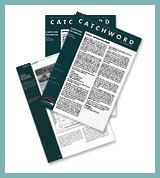Program
7: Communication and Adoption
Program Leader: David Perry, Monash University
 Program
Projects Program
Projects
Click here
for the current list of Projects for this Program (2003-2006)
Program Overview
Whilst the core business of the Centre is world class research,
we are also committed to the communication and adoption of
our research outcomes - the key performance indicator of the
Centre is the level of adoption of research outcomes.
The Communication and Adoption Program provides leadership
and support for each of the research projects and programs
in planning and implementing activities to achieve the highest
possible level of adoption.
Specific goals of the Communication and Adoption program
include:
- Ensure the integration of effective communication and adoption principles into the planning and implementation of each research program and project.
- Maximise the effectiveness and efficiency of each Program and Project’s resources committed to communication and adoption of research outcomes through the development and implementation of collaborative projects with other programs, industry, other CRCs and research organisations and CRCs.
- Develop and maintain current best practice for the communication and adoption of CRC research outcomes and undertake independent reviews at years one, three and five to monitor the programs effectiveness
- Utilise the potential communication and adoption capacity of the CRC parties (both industry and research) to extend the CRC research outcomes to end-users in the most effective and relevant form.
- Ensure effective communication within the CRC parties and within focus catchments
Strategy
The strategy to achieve these objectives involves six key areas of activity:
- End – User and Stakeholder Involvement
Each Program/Project Leader, with support from this program ensures the close involvement of end-users and stakeholders in the planning and conduct of the research, and in the implementation of the outcomes.
- Effective Communication
The Centre maintains and continues to improve its external communication strategy through:

- Continuing distribution of our high quality monthly newsletter Catchword
to over 1000 recipients each month
- Communicating and implementing the Centre’s research
outcomes in the focus
catchments
- Maintaining a leading-edge World Wide Web site
- Continuing our successful National Industry Seminar Series
- Continuing publication of our Industry and Technical Report and Video series and other similar practical reference materials sought by industry practitioners
- Providing a action learning-based programs of field tours and demonstrations of Centre products tailored to meet the needs of practitioners, community groups and land managers
- Continuing professional education from targeted short courses through to postgraduate scholarships and secondments
- Contribution of groups of feature articles (tailored to practitioners) to key trade journals such as Water and Australian Landcare
- Advocacy
The Centre looks beyond its Parties and focus catchments in a bid to influence the shape of the national land and water management agenda. In pursuit of this objective, the Board and Executive of the Centre assume an advocacy role with national, state, and regional peak bodies involved in land and water management.
- Relationships with small to medium-size enterprises
(SMEs)
The Centre aims to achieve a close dynamic relationship with relevant SMEs. We continue to strengthen our links with SMEs, primarily through the uptake of our graduates and staff by leading environmental consultants. The Centre encourages active involvement with such enterprises via:
- Sub-contracting on major environmental consultancies in Australia and overseas
- Providing specialist training services, particularly in hydrologic modelling
- Licensing of hydrologic modelling software developed by the Centre
- Two-way secondments of staff engaged in hydrologic modelling.
- Commercialisation and Intellectual Property Management
With the heavy investment in this CRC from the public sector, and its emphasis on adoption, commercialisation is a minor aspect of the Centre. Nevertheless, there are always some products for which a formal assessment of financial return is warranted. This is done on a case-by-case basis, with the ultimate decision being made at board level.
- Contract Research
With its skills and knowledge-base in whole-of-catchment
prediction, the Centre is in a position to undertake contract
research – i.e., applications of its technology to
specific problems. Such commissions have a dual benefit
to the Centre: they bring in funds for applied research
and, equally important, speed-up implementation and acceptance.
Consequently, the seeking of appropriate research contracts
forms part of the adoption strategy.
 Outcomes: Outcomes:
- The CRC for Catchment Hydrology will be recognised as delivering a continually improving best practice communication and adoption program.
- CRC Research and Industry Parties will be integrated through the Communication and Adoption Program strategy creating synergies for extending research outcomes to end-users and stakeholders through a two way iterative process.
- Through effective and integrated program management, the Centre’s research outcomes will be adopted by the key end-users and stakeholders and improve the understanding and management of Australia’s land and water resources.
|